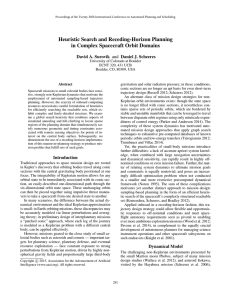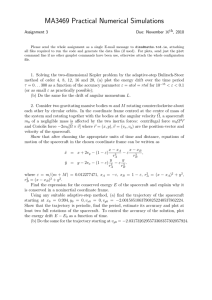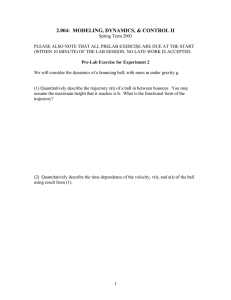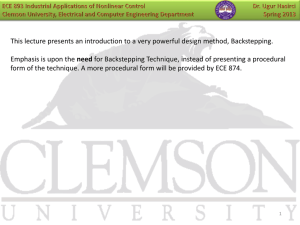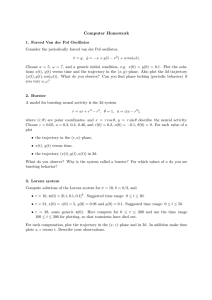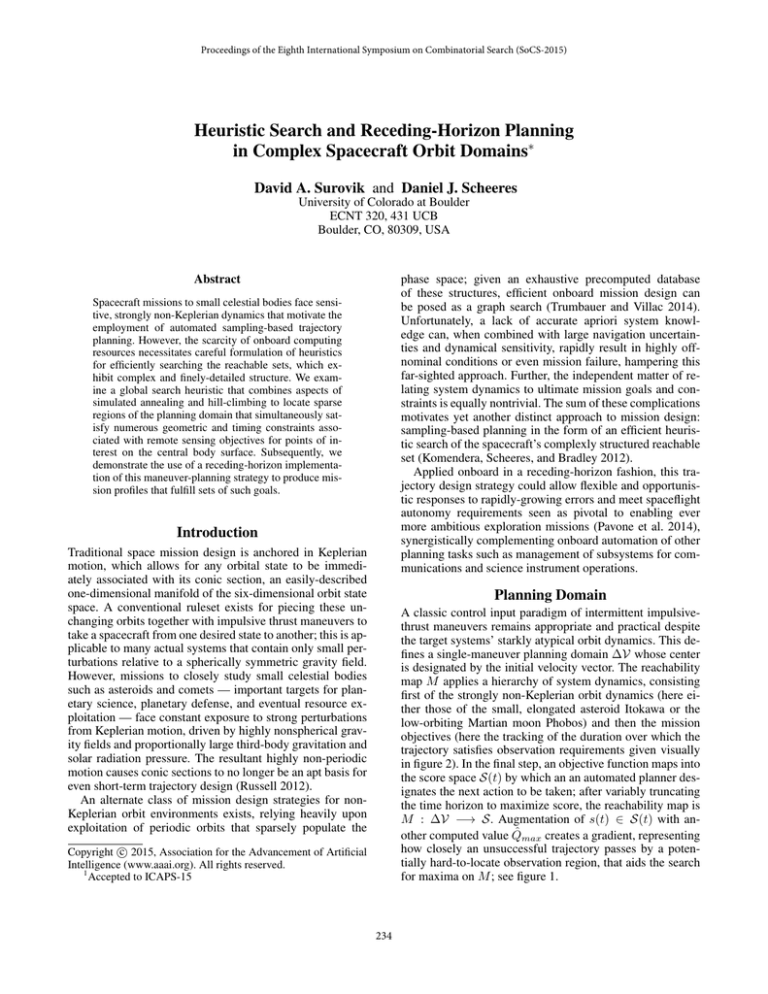
Proceedings of the Eighth International Symposium on Combinatorial Search (SoCS-2015)
Heuristic Search and Receding-Horizon Planning
in Complex Spacecraft Orbit Domains∗
David A. Surovik and Daniel J. Scheeres
University of Colorado at Boulder
ECNT 320, 431 UCB
Boulder, CO, 80309, USA
Abstract
phase space; given an exhaustive precomputed database
of these structures, efficient onboard mission design can
be posed as a graph search (Trumbauer and Villac 2014).
Unfortunately, a lack of accurate apriori system knowledge can, when combined with large navigation uncertainties and dynamical sensitivity, rapidly result in highly offnominal conditions or even mission failure, hampering this
far-sighted approach. Further, the independent matter of relating system dynamics to ultimate mission goals and constraints is equally nontrivial. The sum of these complications
motivates yet another distinct approach to mission design:
sampling-based planning in the form of an efficient heuristic search of the spacecraft’s complexly structured reachable
set (Komendera, Scheeres, and Bradley 2012).
Applied onboard in a receding-horizon fashion, this trajectory design strategy could allow flexible and opportunistic responses to rapidly-growing errors and meet spaceflight
autonomy requirements seen as pivotal to enabling ever
more ambitious exploration missions (Pavone et al. 2014),
synergistically complementing onboard automation of other
planning tasks such as management of subsystems for communications and science instrument operations.
Spacecraft missions to small celestial bodies face sensitive, strongly non-Keplerian dynamics that motivate the
employment of automated sampling-based trajectory
planning. However, the scarcity of onboard computing
resources necessitates careful formulation of heuristics
for efficiently searching the reachable sets, which exhibit complex and finely-detailed structure. We examine a global search heuristic that combines aspects of
simulated annealing and hill-climbing to locate sparse
regions of the planning domain that simultaneously satisfy numerous geometric and timing constraints associated with remote sensing objectives for points of interest on the central body surface. Subsequently, we
demonstrate the use of a receding-horizon implementation of this maneuver-planning strategy to produce mission profiles that fulfill sets of such goals.
Introduction
Traditional space mission design is anchored in Keplerian
motion, which allows for any orbital state to be immediately associated with its conic section, an easily-described
one-dimensional manifold of the six-dimensional orbit state
space. A conventional ruleset exists for piecing these unchanging orbits together with impulsive thrust maneuvers to
take a spacecraft from one desired state to another; this is applicable to many actual systems that contain only small perturbations relative to a spherically symmetric gravity field.
However, missions to closely study small celestial bodies
such as asteroids and comets — important targets for planetary science, planetary defense, and eventual resource exploitation — face constant exposure to strong perturbations
from Keplerian motion, driven by highly nonspherical gravity fields and proportionally large third-body gravitation and
solar radiation pressure. The resultant highly non-periodic
motion causes conic sections to no longer be an apt basis for
even short-term trajectory design (Russell 2012).
An alternate class of mission design strategies for nonKeplerian orbit environments exists, relying heavily upon
exploitation of periodic orbits that sparsely populate the
Planning Domain
A classic control input paradigm of intermittent impulsivethrust maneuvers remains appropriate and practical despite
the target systems’ starkly atypical orbit dynamics. This defines a single-maneuver planning domain ∆V whose center
is designated by the initial velocity vector. The reachability
map M applies a hierarchy of system dynamics, consisting
first of the strongly non-Keplerian orbit dynamics (here either those of the small, elongated asteroid Itokawa or the
low-orbiting Martian moon Phobos) and then the mission
objectives (here the tracking of the duration over which the
trajectory satisfies observation requirements given visually
in figure 2). In the final step, an objective function maps into
the score space S(t) by which an an automated planner designates the next action to be taken; after variably truncating
the time horizon to maximize score, the reachability map is
M : ∆V −→ S. Augmentation of s(t) ∈ S(t) with another computed value Q̂max creates a gradient, representing
how closely an unsuccessful trajectory passes by a potentially hard-to-locate observation region, that aids the search
for maxima on M ; see figure 1.
c 2015, Association for the Advancement of Artificial
Copyright Intelligence (www.aaai.org). All rights reserved.
1
Accepted to ICAPS-15
234
additional subtleties of planning: maneuver timing (selection of trajectory lifespan ∆t) and consideration of prospects
beyond the planning horizon. The current implementation of
ph enforces a preference for arc termination at altitudes in
the range associated with the observation regions, providing
favorable structure of the next M . Each planning cycle thus
uses a heuristic search to identify an available action and
trajectory lifespan (∆t, ∆v) that maximize s ∈ S (t; ∆V),
providing a balance of short-term progress with long-term
prospects. Repeated application of this scheme produces
mission profiles that fulfill all goals, as seen in figure 2,
while its sampling-based nature implies an ability to accommodate any possible dynamical model and mission requirement set, limited solely by onboard computational power.
Figure 1: Left: Level surface of augmented objective function in M . Center: Monte Carlo mean performance of search
heuristics. Right: Sparseness of high-scoring regions.
Heuristic Search
The nonintegrability of the dynamical model necessitates
a sampling-based approach for charting M . A heuristicbased iterative mesh refinement strategy is used to drastically improve the efficiency of this process relative to a simple grid search (Komendera, Scheeres, and Bradley 2012;
Surovik and Scheeres 2015). Beginning with an initial random or grid sample of maneuvers ∆vi ∈ ∆V, scores s ∈ S
are computed via numerical integration. Next, Delaunay Triangulation is used to build this small sample of points in M
into a mesh, i.e. a set of tetrahedral “simplex” volume elements each bounded by four vertices, to allow inference
of its continuous structure. The search heuristic then operates on the mesh, assigning each j-th simplex a weight Wj
based upon the extent to which the numerically propagated
results of its vertices indicate that it contains relevant missing detail. Finally, a random sample of simplex IDs is taken
to determine the locations of the next maneuver sample set.
This process of meshing, propagation, and heuristic search
is repeated until a specified final sample size is reached.
Weights are assigned such that the random sample of discrete elements functions in a roughly continuous manner.
n
o
Wj =Vj · mean {∆t} · max s + Q̂max ˆ 28τ
(1)
j
Figure 2: Rotating-frame solution at Phobos and inertialframe solution at Itokawa; diamonds denote start/end of successful observations, demonstrating satisfaction of viewing
geometry (colored regions) and Sun-phasing requirements.
Acknowledgments. This research is supported by
NASA Space Technology Research Fellowship grant
#NNX12AM40H.
References
Komendera, E.; Scheeres, D. J.; and Bradley, E. 2012. Intelligent computation of reachability sets for space missions.
Proceedings of the 24th Conference on Innovative Applications of Artificial Intelligence.
Pavone, M.; Acikmese, B.; Nesnas, I. A.; and Starek, J.
2014. Spacecraft autonomy challenges for next generation
space missions. In Lecture Notes in Control and Information
Systems. Springer.
Russell, R. P. 2012. Survey of spacecraft trajectory design
in strongly perturbed environments. Journal of Guidance,
Control, and Dynamics 35(3):705–720.
Surovik, D., and Scheeres, D. J. 2014. Autonomous maneuver planning at small bodies via mission objective reachability analysis. AIAA/AAS Astrodynamics Specialist Conference.
Surovik, D. A., and Scheeres, D. J. 2015. Adaptive reachability analysis to achieve mission objectives in strongly nonkeplerian systems. Journal of Guidance, Control, and Dynamics 38(3):468–477.
Trumbauer, E., and Villac, B. 2014. Heuristic search-based
framework for onboard trajectory redesign. Journal of Guidance, Control, and Dynamics 37(1):164–175.
j
The first factor, simplex volume V , normalizes the uneven
sample distribution while the second, the mean trajectory
lifespan, scales sample probability density in accordance
with the varying temporal depth of M and the final factor
biases the search in proportion to the gradient-augmented
score. As the refinement completion factor τ increases from
0 to 1, the exponent of the bias term causes it to be progressively amplified, causing the global search to hone in on
maxima in a manner akin to Simulated Annealing or Rapid
Random Trees (though the notion of paths does not apply to
this search domain). Monte Carlo mean results of searches
of a typical planning domain are plotted in figure 1.
Receding-Horizon Planner
To complete a set of several observation objectives, this
maneuver design scheme is applied in a receding-horizon
fashion (Surovik and Scheeres 2014), as has frequently
been deemed appropriate for aerospace vehicle motion planning scenarios in highly dynamic environments. A horizon
prospect function ph (x(t)) is formulated to account for two
235


